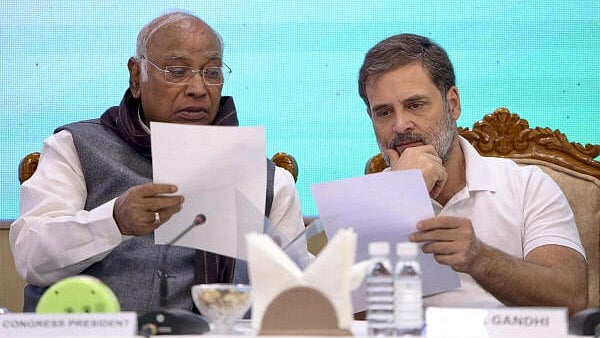
Congress President Mallikarjun Kharge with LoP in the Lok Sabha and party leader Rahul Gandhi
Credit: PTI File Photo
New Delhi: Congress promised that 2025 would be a year of organisational revamp and in its first major exercise in this direction, the leadership brought in tried and tested leaders back into action along with some young faces, while showing the door to some.
The composition of the new office bearers showed that five of them are OBCs while three are from the upper caste and one each SC, ST and minority, keeping in mind the Udaipur Declaration decision. Around 70-75 per cent of the senior leadership are now from the OBC, SC, ST and minority communities.
A meeting of General Secretaries and in-charges is scheduled on February 19, sources said.
There were no large-scale changes as some leaders were relieved of their additional charges of states while retaining their primary responsibilities. The leadership did look at performance of some of the in-charges and the axe fell on them though all of them have not taken it lightly.
Senior MP Rajeev Shukla, who was divested of his responsibilities of Himachal Pradesh and Chandigarh, thanked the leadership for the opportunity but only after listing his successes.
"I tried my level best to bring the government in Himachal and then stabilise it after a major setback. Congress also won Lok Sabha in Chandigarh after a long time because of full support of party leadership to me," he posted on 'X'.
The distribution of responsibilities and choices for states clearly sends a signal. It has brought back earlier shunted-out leaders like Harish Chaudhary, Rajani Patil and B K Hariprasad, owing to their experience and the priority the leadership gave the states that they have been assigned to.
Chaudhary has been sent to Madhya Pradesh, where Jitendra Singh was holding additional charge and a young state president Jitu Patwaria is trying to put the organisation back on track, while Patil has been sent to Himachal Pradesh where the party rules. Hariprasad has been assigned Haryana where the party now wants to build its organisational structure, which is absent since 2013.
The list bore the imprint of Leader of Opposition in Lok Sabha Rahul Gandhi in the changes, especially with three of his close aides who worked with him in organisational matters bagging prominent assignments by finding space in a list of two General Secretaries and nine in-charges.
K Raju, the go-to-man for Rahul when it comes to ‘Bahujan’ politics, has been given the responsibility of Jharkhand where the I.N.D.I.A. bloc is in power while activist-turned-politician Meenakshi Natarajan has been given the charge of Telangana where the Congress government is planning big ticket changes on social engineering.
Already, the Telangana government has released the caste census data and is planning sub-categorisation of Dalits, both of which have run into trouble. The appointment of Krishna Allavaru in place of Mohan Prakash, who Rahul considers highly, is also a message to the leaders that the leadership is looking at results.
Choosing former Chhattisgarh Chief Minister Bhupesh Baghel, who is considered close to Priyanka Gandhi Vadra and known for his election management skills, and the return of Karnataka veteran B K Hariprasad as in-charge after a gap showed the party’s seriousness in handling the states – Punjab and Haryana respectively – given to them.
The list also bore the leadership’s intent to groom leaders for the future. Syed Naseer Hussain, Allavaru and Saptagiri Ulaka are sharing space in the list with seniors like Chaudhary, Ajay Kumar Lallu, Hariprasad, Girish Chodankar and Patil.
Nasir’s rise in the Congress hierarchy has been fast – from a spokesperson to the party's Rajya Sabha Whip to Coordinator in the Congress President's office as well as a member of the Congress Working Committee in the past few years.
